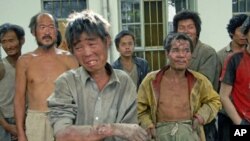The U.S. State Department estimates there are millions of people working in slavery around the world today. Many of the 27 million people in slavery are believed to be involved in the supply chain that goes into creating everyday products used by unsuspecting consumers. There's a new way, though, that consumers can determine the amount of slave labor used on a particular product.
An innovative website may shock many of those who take its lifestyle survey. That survey provides an estimate of how many slaves may have worked to grow food, sew clothing or mine the materials for a cell phone.
The web site, www.slaveryfootprint.org, and a similar mobile application were created by the Fair Trade Fund, a California-based nonprofit group, with a $200,000 State Department grant. The fund is headed by Justin Dillon. He said the web site does not single out any particular company, but encourages them to make sure slaves are not part of the supply chain for their products.
“Part of that equation is to give consumers a way to understand the issue, personalize the issue for themselves based on anonymous products, and then be able to speak to the producers that they do love and use every day, and tell them they not only know this, but that they would like to work with them,” said Dillon.
Many slaves at work globally
Dillon defines a slave as anyone forced to work without compensation and who cannot leave the job. Slavery Footprint quantifies evidence of forced labor that may be used in the production process.
The web site was unveiled at a news conference in New York City during the annual Clinton Global Initiative. The U.S. Ambassador at Large for the State Department’s Office to Monitor and Combat Trafficking in Persons, Luis CdeBaca, said all consumers have slaves working for them, even if they don’t buy sex from people forced into sex slavery, or have an enslaved maid or a farm where men are forced to pick fruit.
“We create the demand that the traffickers respond to through force and coercion. And through the launch of slaveryfootprint.org, we will be able to have everyone look at their own consumption patterns. Hopefully out of that comes consumer activism, comes group activism,” said CdeBaca.
The president of the Alliance to Stop Slavery, Julia Ormond, appealed to the CEOs of companies to get involved in the issue by investigating their supply chains for possible slavery. She said fiduciary responsibility of CEOs to shareholders should be value, not just profits.
“Because profit makes you climb on each others’ backs to have competitive prices, and when it gets so competitive, it gets cheaper and cheaper and cheaper, to a point where you force a condition around the first purchase point that creates an environment for trafficking and slavery,” said Ormond.
Growing awareness of problem
Dillon said the cost of eliminating slaves from the supply chain for multinational corporations would be miniscule. Only the slave drivers would lose money, he said, because the slaves themselves are so plentiful that they are disposable and therefore driven to the breaking point.
The web site also informs visitors that slaves are used, for example, to mine mica, the mineral used to provide sparkle in cosmetics, or coltan, a component in electronics. Also, rubies and teakwood exported from Burma are reported to use slave labor, as are soccer balls from China, cotton from Uzbekistan, carpeting from India, and shrimp from Southeast Asia.
Participating in the anti-slavery campaign is MTV, a popular cable-TV music channel. It is donating free time on one of its affiliates to publicize the issue on 300 American college campuses.
Web Site Shows Extent of Forced Labor Used to Make Everyday Products






